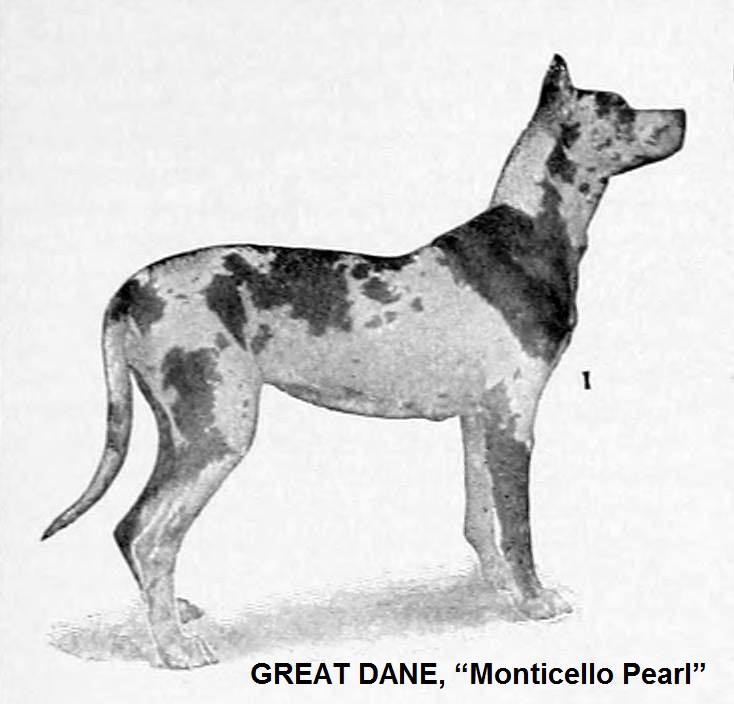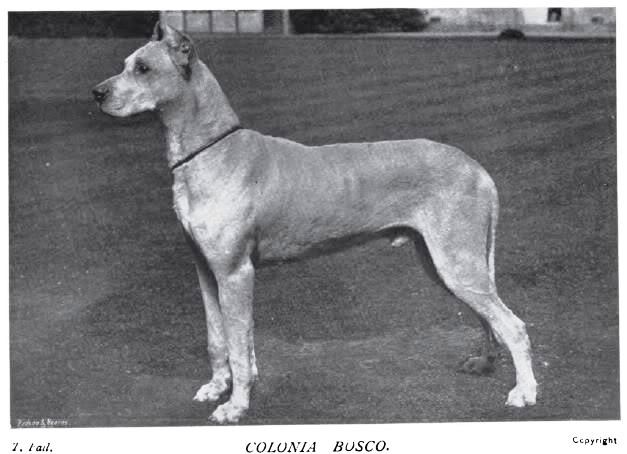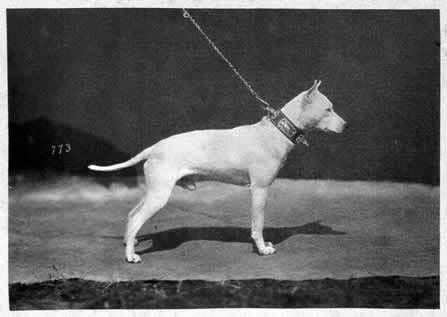The first American standard of the Great Dane, published in 1892, contains a rather interesting reference to the Bull Terrier in the head section, which can perhaps be seen as strange and inexplicable at first:
“The whole formation and expression of the head and face should rather more resemble the hound than the bulldog or mastiff, except the muzzle, which is not like that of any other breed, as the German Mastiff or Great Dane has a muzzle peculiarly his own, the entire head and face, but much heavier, more nearly resembling those of the approved bull terrier than of any other breed. Too much resemblance to the hound is a fault.”
Now, this reference may indeed perplex the reader who is not familiar with Bull Terrier history, thinking that the breed always looked like it does today, with an egg-shaped head.
Of course that is not the case so I believe I can shed some light on the comparison between the Great Dane of 1892 and the Bull Terrier of the same vintage; to explain why this breed was used to create a visual reference to the readers of the first standard in the United States, we first need to remember that the American dog fanciers at the time were naturally far more familiar with their various English terriers rather than with the Dane.
Further aid comes from the New International Encyclopedia, an American encyclopedia first published in 1902 and updated in 1906, 1914 and 1926. The article about Dogs was written by Ernest Ingersoll, renowned American naturalist and explorer; in the 1905 edition it is illustrated by two very nice plates, containing photographs of various breeds, that you can view here and here. The first plate, conveniently for us, includes a Great Dane and the second plate is very helpful also as it features an eponymous Bull Terrier.


Immediately it becomes evident why the reference to the Bull Terrier of that period was justified in order to create a mental image of the muzzle’s shape in the first American Great Dane Standard. The Great Dane was at the time a smart-looking dog with a racy, sporting outline and clean, dry head without the jowly appendages, hanging bloodhoundy ‘flews’, excess skin and droopy lips that some people are so enamored with nowadays. Emphasis in the early standards was correctly placed on strength and depth of jaw rather than drop of lip, as what’s important is bone structure, while often abundance of lip disguises a weak underjaw – I would even go as far as to say that in some breeds and in some lines in our breed, excess lip and lack of underjaw are presented together, and there is a simple anatomical reason for this, which I’ll come to in due course.
As strength and depth of jaw (which determines the effectiveness of the bite in hunting big game) is not field tested in breeds that do not work , it’s easily forgotten and neglected in breeding companion dogs. Our saving grace is that the Great Dane muzzle is also required to be broad, almost as broad as the skull. Yet even with that clause it’s not unusual to find crowded, very small, or misaligned bottom incisor teeth in Great Dane mouths. But that is for another day and other posts, where we’ll discuss the head in more detail.

The original Great Dane did not have a visually perfect rectangular muzzle profile, created by the drop of lip squarely cut-off in the front, but a more natural-looking muzzle as seen from the side, tapering very slightly towards the nose, with the lips just covering it, very like those early bull terriers. That is precisely the type of head expected on a powerful Hound, or any breed that was developed to hunt and grab onto prey, big or small, without its own lips getting in the way; or to bite the agitator’s sleeve / full body protective suit in modern protection dog sports. That’s why you won’t find lips hanging below the jaw on a Dogo Argentino, or an Irish Wolfhound, or indeed a Bull Terrier, even today; and why you won’t find loose lipped individuals or breeds among working protection dogs.
To our contemporary eye those early heads might appear snipey because of the lack of abundant drop of lip, but what’s important is always to discern between lack of lip and lack of jaw. Good early heads did not lack underjaw, even when they did lack lip overhang. Dogs back then also had more developed masseter muscles, making their heads look somewhat more cheeky to us today, adding to the impression created by the lack of drop in lip. Again, we will revisit the subject in future posts about the Great Dane head.

A picture of the old English White Terrier, the Bull Terrier’s ‘parent’ breed, taken in 1890, is also enlightening, as the clean-cut head with the slight but visible stop, flat skull, planes parallel or thereabouts (at least on some specimens) and roughly equal lengths of skull and muzzle, are quite like the parameters also required for the Great Dane, despite the difference in size between the two breeds. The similarities end there, but in profile, the muzzles are not too dissimilar at that time.

English White Terrier, 1890

Bull Terrier, 1915
Another picture, of a Bull Terrier in 1915, above, shows a muzzle quite similar to that of our early Dane, as pictured in the 1903 illustration of the British Standard.

The Great Dane in 1903
Early Bull Terriers
In fact, the Bull Terrier around the turn of the 19th century, as we can see in these photographs above, was a very beautiful athletic animal, without the modern breed’s heaviness and oval head; it wouldn’t be unfair to say that the early Bull Terrier was racy, shapely, balanced and, with its “elegance of outline and grace of form” almost resembling a Great Dane in miniature. Today this classy look can be seen almost exclusively in APBTs (American Pit Bull Terriers), while show BTs (Bull Terriers) are following the same trend of excess and mastiffication as the plague of hyper-type some of our Danes suffer from.


No comments:
Post a Comment